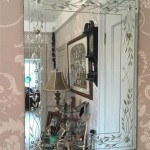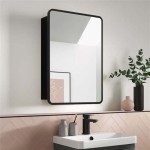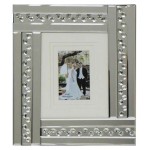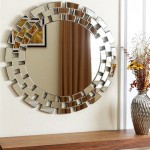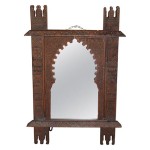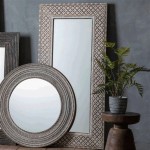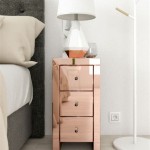The Transformative Power of Wall Mirrors: A Comprehensive Decorating Guide
Mirrors are more than just reflective surfaces; they are potent design tools that can significantly enhance the aesthetics and functionality of any interior space. When strategically placed, wall mirrors can amplify natural light, create the illusion of greater space, and add a touch of elegance and sophistication to a room. The versatility of mirrors allows them to be incorporated into various design styles, from minimalist modern to ornate traditional.
This article will explore the various ways wall mirrors can be used to elevate interior design, providing practical tips and insights to help homeowners and designers effectively integrate mirrors into their decorating schemes. From understanding the different types of mirrors available to mastering the art of placement and styling, this guide will provide a comprehensive overview of mirror decor.
Key Considerations Before Installation
Before embarking on a wall mirror decorating project, several critical factors must be considered to ensure optimal results. These considerations include the size and shape of the mirror, the style and frame, the placement in the room, and the existing decor.
Size and Shape: The appropriate size of the mirror should be proportionate to the wall space and the surrounding furniture. A mirror that is too small will appear insignificant, while a mirror that is too large may overwhelm the space. Similarly, the shape of the mirror should complement the overall design aesthetic. Rectangular mirrors are versatile and suitable for hallways and living rooms, while round or oval mirrors can add a softer touch to bedrooms and bathrooms. Consider the function of the room as well; a full-length mirror in a bedroom is practical, while a smaller, decorative mirror might be more suitable for an entryway.
Style and Frame: The style of the mirror should align with the overall design theme of the room. A sleek, frameless mirror is ideal for a modern or minimalist setting, while an ornate, gilded frame will complement a traditional or vintage-inspired space. The frame material also plays a role in the overall aesthetic. Wood frames provide warmth and texture, metal frames offer a contemporary edge, and mirrored frames amplify the reflective qualities.
Placement: Placement is crucial for maximizing the benefits of a wall mirror. Consider the light sources in the room and position the mirror to reflect natural light, making the space brighter and more inviting. Avoid placing mirrors directly opposite unattractive views or cluttered areas, as this will simply reflect the undesirable elements. Instead, position mirrors to reflect artwork, greenery, or other visually appealing features. In hallways, mirrors can be placed to elongate the space and create a sense of depth. In small rooms, strategically positioned mirrors can create the illusion of a larger area.
Existing Decor: The mirror should complement the existing decor, not clash with it. Consider the colors, textures, and patterns in the room and choose a mirror that harmonizes with these elements. If the room is already heavily detailed, a simpler mirror may be more appropriate. Conversely, if the room is relatively plain, a more decorative mirror can add visual interest.
Careful consideration of these factors will ensure that the chosen mirror enhances the overall aesthetic of the room and fulfills its intended function.
Maximizing Space and Light
One of the most significant benefits of using wall mirrors in interior design is their ability to maximize space and light. Mirrors reflect light, effectively doubling the perceived brightness of a room. They also create the illusion of more space, making them particularly useful in small or confined areas.
Amplifying Natural Light: Placing a mirror opposite a window is a simple yet effective way to amplify natural light. The mirror will reflect the sunlight, spreading it throughout the room and making it feel brighter and more airy. This technique is particularly beneficial in rooms that receive limited natural light. Consider the angle of the sunlight and adjust the mirror's position accordingly to maximize its reflective capabilities. During the summer months, be mindful of potential glare and adjust the angle of the mirror to mitigate any discomfort.
Creating the Illusion of Space: Mirrors can visually expand a room, making it feel larger than it actually is. A large wall mirror, particularly in a small room, can create the illusion of depth and make the space feel more open. Consider using a full-length mirror on a narrow wall to widen the room visually. In hallways, mirrors can be used to elongate the space and create a sense of flow. Experiment with different positions and sizes of mirrors to find the optimal configuration for each room. Avoid using too many small mirrors in a small space, as this can create a fragmented and cluttered effect.
Strategic Placement in Specific Rooms: In living rooms, a large mirror above the fireplace or sofa can serve as a focal point and enhance the sense of spaciousness. In bedrooms, mirrors can be placed on closet doors or walls to reflect light and create a more open and airy atmosphere. In bathrooms, mirrors are essential for practical purposes, but they can also be used to create a more luxurious and spa-like feel. Consider using a large, well-lit mirror above the vanity to enhance the functionality of the space. In dining rooms, mirrors can reflect candlelight and create a more intimate and inviting atmosphere.
By strategically placing mirrors to maximize light and space, homeowners and designers can transform even the smallest and darkest rooms into bright and inviting spaces.
Creative Mirror Arrangements and Styling
Beyond simply hanging a single mirror on a wall, there are numerous creative ways to arrange and style mirrors to add visual interest and personality to a space. These techniques include creating mirror galleries, using mirrored furniture, and incorporating decorative mirror accents.
Mirror Galleries: A mirror gallery is a collection of mirrors arranged on a wall in a cohesive and visually appealing manner. This technique allows for a more personalized and eclectic look, as it incorporates mirrors of different shapes, sizes, and styles. When creating a mirror gallery, consider the overall theme and color palette of the room. Choose mirrors that complement each other and create a sense of harmony. Experiment with different layouts and arrangements before committing to a final design. Consider using a mix of horizontal and vertical mirrors to add visual interest. Maintain consistent spacing between the mirrors to create a balanced and cohesive look. Use a level to ensure that the mirrors are hung straight and evenly aligned.
Mirrored Furniture: Mirrored furniture adds a touch of glamour and sophistication to any space. Mirrored coffee tables, side tables, and dressers reflect light and create a sense of openness. This technique is particularly effective in small or dark rooms, as it amplifies the available light and creates the illusion of more space. When using mirrored furniture, be mindful of the overall aesthetic of the room. Choose pieces that complement the existing decor and avoid overdoing it. Too much mirrored furniture can create a gaudy or overwhelming effect. Balance the mirrored furniture with other textures and materials to create a balanced and visually appealing space.
Decorative Mirror Accents: Decorative mirror accents can add subtle touches of elegance and visual interest to a room. These accents can include mirrored trays, candle holders, and wall sconces. Consider using mirrored coasters or placemats to reflect light and add a touch of glamour to a dining table. Mirrored wall sconces can provide ambient lighting and create a warm and inviting atmosphere. Mirrored trays can be used to display decorative objects or serve refreshments. When using decorative mirror accents, be mindful of the overall style of the room. Choose pieces that complement the existing decor and avoid using too many accents in a small space.
By experimenting with different mirror arrangements and styling techniques, homeowners and designers can create unique and personalized spaces that reflect their individual tastes and preferences. The strategic use of mirrors can transform a room from ordinary to extraordinary, adding depth, light, and visual interest.
Ultimately, the key to successful wall mirror decorating lies in careful planning, thoughtful execution, and a keen eye for detail. By considering the factors outlined in this guide, homeowners and designers can harness the transformative power of mirrors to create spaces that are both beautiful and functional.

10 Ideas For Decorating With Mirrors Stance Studies On The Family Living Room Decor Wall

10 Startling Wall Mirror Decor Ideas That You Must See Today

13 Mirrors Gallery Walls Ideas To Copy Lolly Jane

Decorating Walls With Mirrors Professional Tips To Know Decoholic

How To Decorate With Mirrors Decorating Ideas For

25 Wall Mirror Decorating Ideas That Will Enhance Your Home Decor

7 Ways To Decorate With Mirrors Thistlewood Farm

5 Extraordinary Wall Mirror Ideas To Adorn Your Home

Mirror Decoration For Home 15 Ideas To Decorate With Mirrors

7 Beautiful Ways To Decorate With Mirrors One Brick At A Time Mirror Wall Living Room Interior Design Decor
